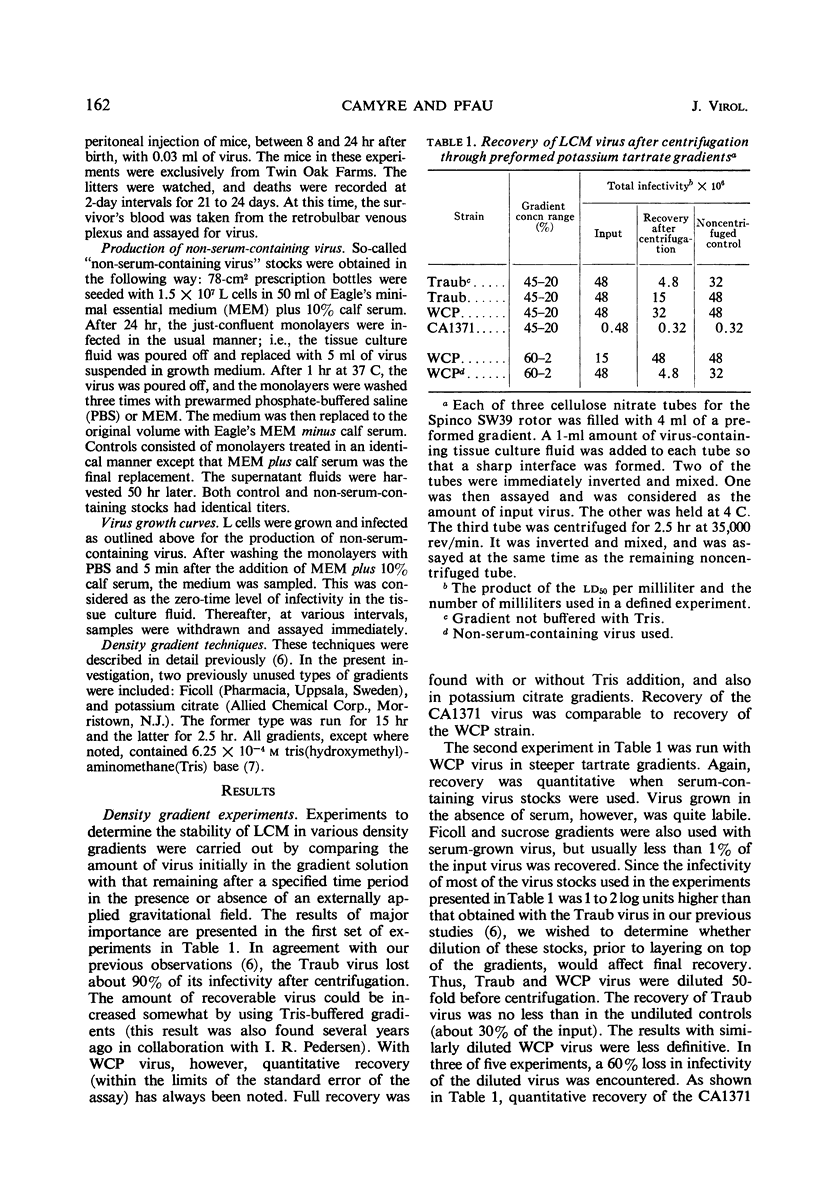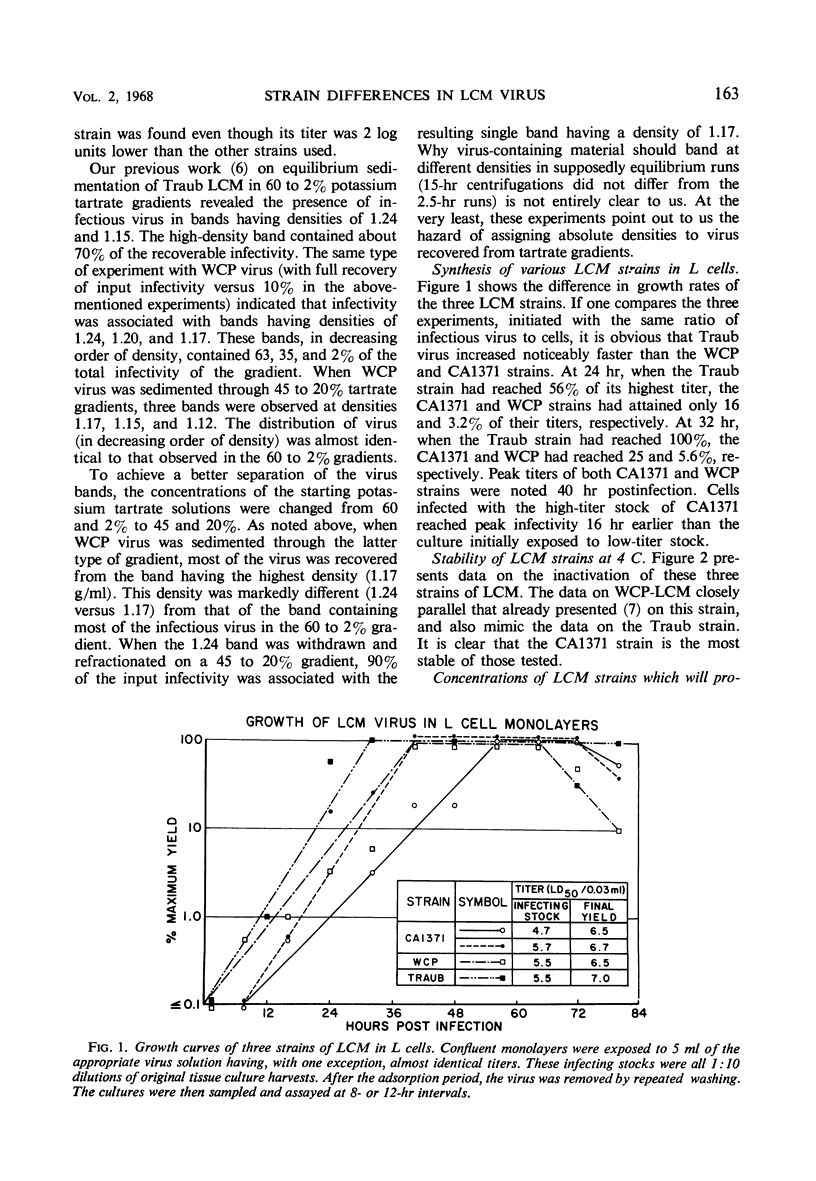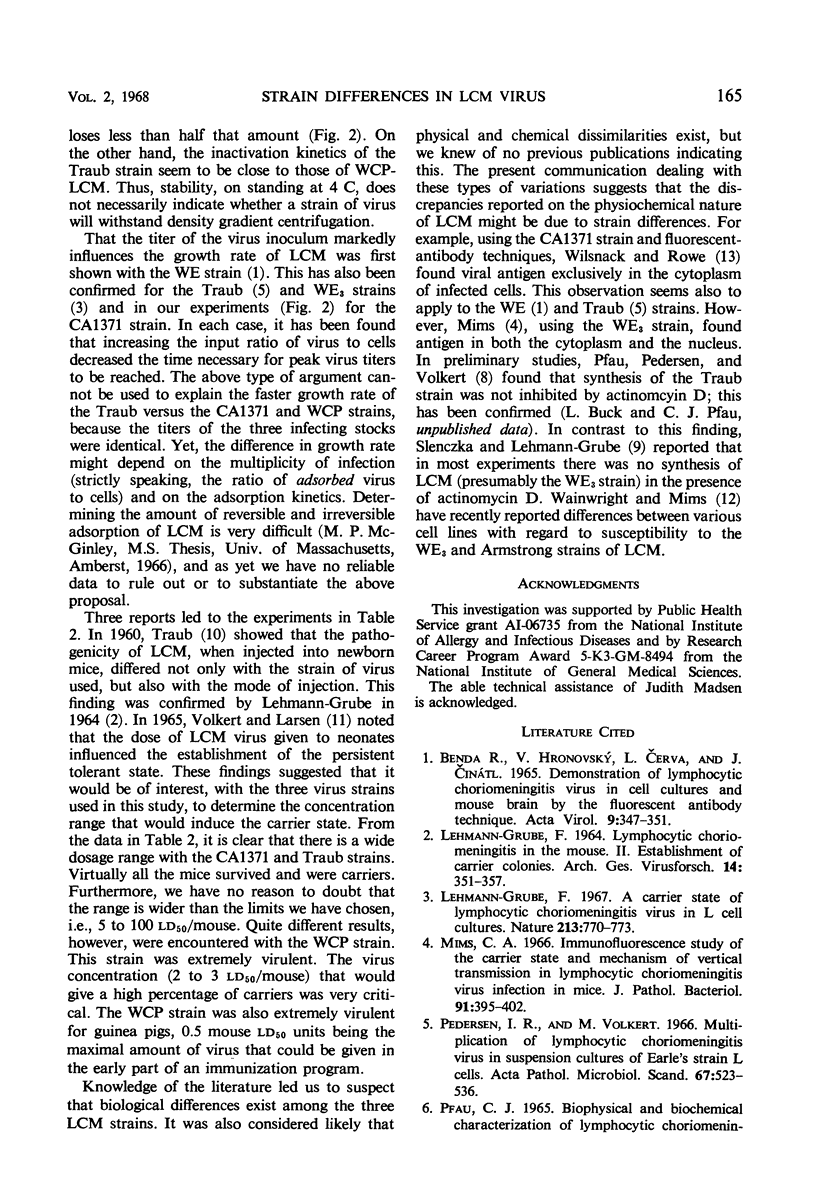Abstract
Biological, biochemical, and biophysical properties of three lymphocytic choriomeningitis (LCM) virus strains were compared. The biological property examined was the concentration range of virus which would, when injected into neonates, cause a carrier state. The dosage range for the CA1371 and Traub strains was found to be as broad as the limits examined (5 to 100 ld50 units/mouse). The WCP strain, however, would only produce carriers within a 3 to 5 ld50 range. The biochemical properties examined were the growth rates in tissue culture and the effect of varying the input ratio of virus to cells. With identical input ratios, the Traub strain reached a peak titer 32 hr after infection. The CA1371 and WCP strain reached their peaks at the 40th hr. With a 10-fold decrease in the amount of CA1371 virus per cell, peak titer (as high as in the above experiments) was not obtained until 56 hr postinfection. The biophysical properties examined were stability in density gradients and inactivation rates at 4C. In potassium tartrate gradients, full recovery of the CA1371 and WCP strain could be achieved. However, inactivation kinetics showed that only the CA1371 strain was much more stable than the Traub-LCM. The realization that marked differences in LCM strains exist is discussed in relation to certain inconsistencies in the literature.
Full text
PDF





Selected References
These references are in PubMed. This may not be the complete list of references from this article.
- LEHMANN-GRUBE F. LYMPHOCYTIC CHORIOMENINGITIS IN THE MOUSE. II. ESTABLISHMENT OF CARRIER COLONIES. Arch Gesamte Virusforsch. 1964;14:351–357. doi: 10.1007/BF01555828. [DOI] [PubMed] [Google Scholar]
- Lehmann-Grube F. A carrier state of lymphocytic choriomeningitis virus in L cell cultures. Nature. 1967 Feb 25;213(5078):770–773. doi: 10.1038/213770a0. [DOI] [PubMed] [Google Scholar]
- Mims C. A. Immunofluorescence study of the carrier state and mechanism of vertical transmission in lymphocytic choriomeningitis virus infection in mice. J Pathol Bacteriol. 1966 Apr;91(2):395–402. doi: 10.1002/path.1700910214. [DOI] [PubMed] [Google Scholar]
- PFAU C. J., PEDERSEN I. R., VOLKERT M. INABILITY OF NUCLEIC ACID ANALOGUES TO INHIBIT THE SYNTHESIS OF LYMPHOCYTIC CHORIOMENINGITIS VIRUS. Acta Pathol Microbiol Scand. 1965;63:181–187. doi: 10.1111/apm.1965.63.2.181. [DOI] [PubMed] [Google Scholar]
- Pedersen I. R., Volkert M. Multiplication of lymphocytic choriomeningitis virus in suspension cultures of Earle's strain L cells. Acta Pathol Microbiol Scand. 1966;67(4):523–536. doi: 10.1111/apm.1966.67.4.523. [DOI] [PubMed] [Google Scholar]
- Pfau C. J., Camyre K. P. Biophysical and biochemical characterization of lymphocytic choriomeningitis virus. 3. Thermal and ultrasonic sensitivity. Arch Gesamte Virusforsch. 1967;20(4):430–437. doi: 10.1007/BF01275223. [DOI] [PubMed] [Google Scholar]
- TRAUB E. [On immunological tolerance in lymphocytic choriomeningitis in mice]. Zentralbl Bakteriol. 1960 Feb;177:472–487. [PubMed] [Google Scholar]
- VOLKERT M., LARSEN J. H. STUDIES ON IMMUNOLOGICAL TOLERANCE TO LCM VIRUS. 5. THE INDUCTION OF TOLERANCE TO THE VIRUS. Acta Pathol Microbiol Scand. 1965;63:161–171. doi: 10.1111/apm.1965.63.2.161. [DOI] [PubMed] [Google Scholar]
- WILSNACK R. E., ROWE W. P. IMMUNOFLUORESCENT STUDIES OF THE HISTOPATHOGENESIS OF LYMPHOCYTIC CHORIOMENINGITIS VIRUS INFECTION. J Exp Med. 1964 Nov 1;120:829–840. doi: 10.1084/jem.120.5.829. [DOI] [PMC free article] [PubMed] [Google Scholar]
- Wainwright S., Mims C. A. Plaque assay for lymphocytic choriomeningitis virus based on hemadsorption interference. J Virol. 1967 Oct;1(5):1091–1092. doi: 10.1128/jvi.1.5.1091-1092.1967. [DOI] [PMC free article] [PubMed] [Google Scholar]


